Medication Calendar
-
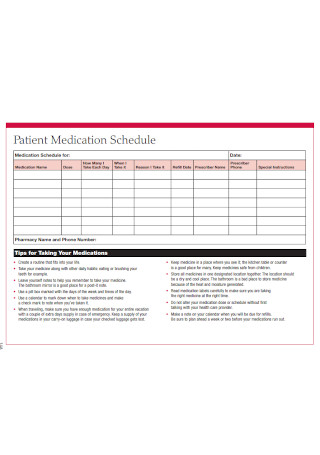
Patient Medication Schedule
download now -
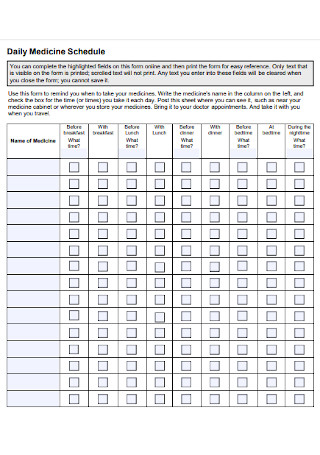
Daily Medicine Schedule Template
download now -
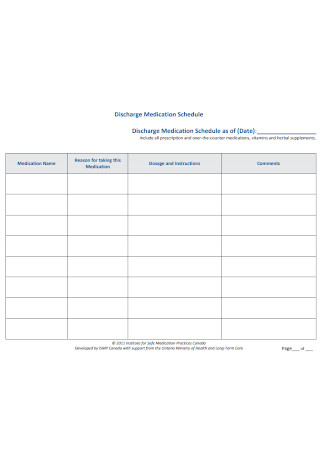
Discharge Medication Schedule Template
download now -
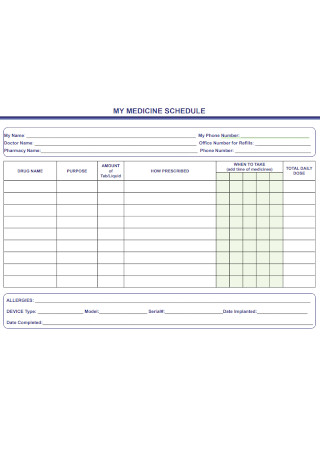
Sample Medication Schedule Template
download now -
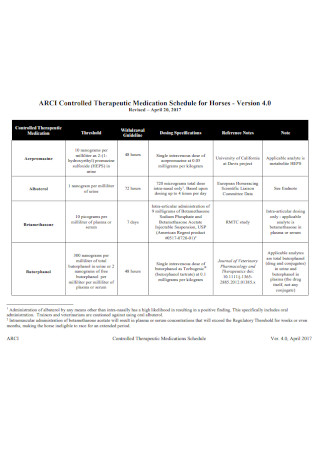
Medication Schedule for Horses
download now -

Medication Schedule for Rush Injection Template
download now -
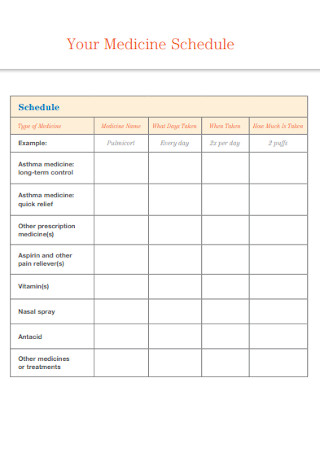
Simple Medicine Schedule Template
download now -
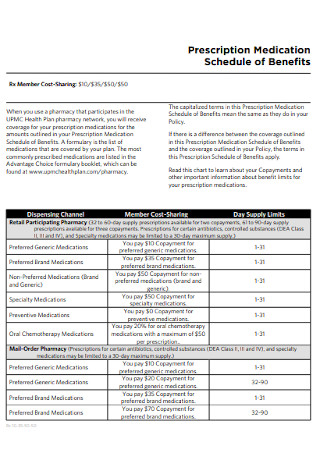
Prescription Medication Schedule of Benefits Template
download now -
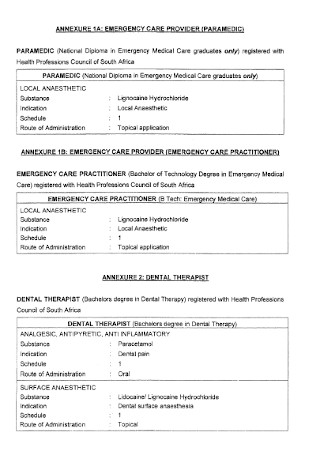
Emergency Medication Schedule Template
download now -
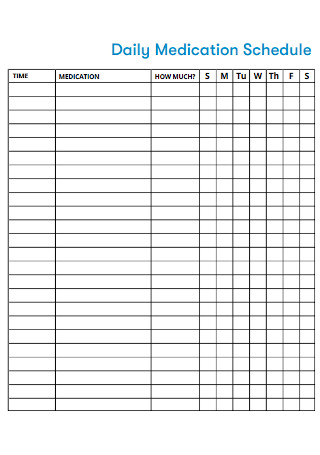
Sample Daily Medication Schedule Template
download now -
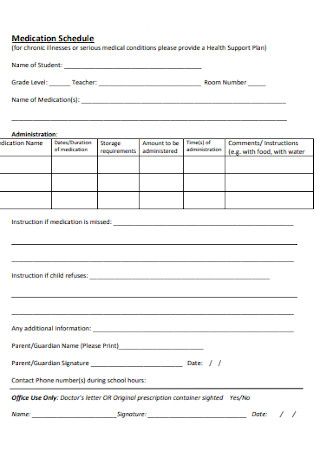
Basic Medication Schedule Template
download now -
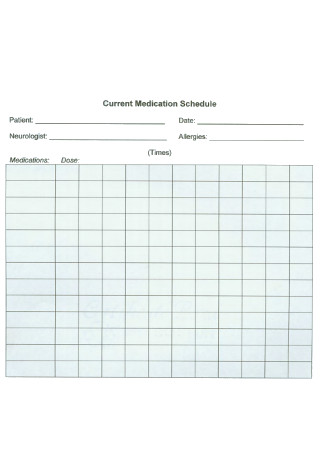
Current Medication Schedule Template
download now -

Sample Controlled Therapeutic Medication Schedule Template
download now -
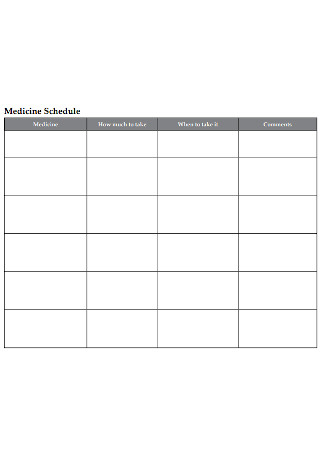
Standard Medicine Schedule Template
download now -
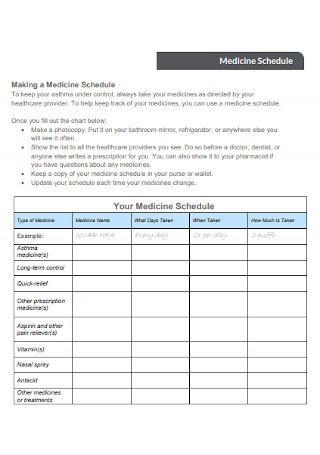
Sample Health Medicine Schedule Template
download now -
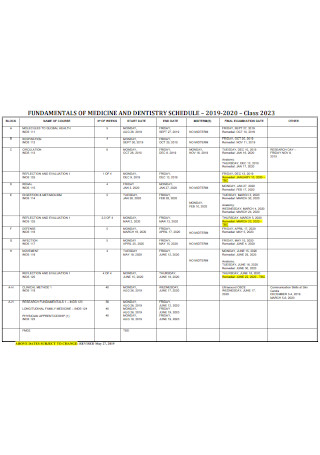
Fundamentals of Medicine and Dentistry Schedule Template
download now -
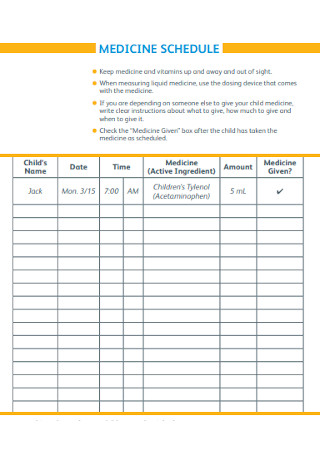
Formal Medicine Schedule Template
download now -

Medication Schedule for SeizureTracker
download now
FREE Medication Schedule s to Download
Medication Calendar
What Is a Medication Schedule?
Importance of Keeping a Medication Schedule
How To Organize Your Medications
FAQs
How many times should I check the medication schedule of my patient before administering drugs?
What are the important things I should consider before administering medication?
What are the common causes of medication errors?
What Is a Medication Schedule?
To forget is human. Taking multiple prescription pills on a schedule can cause confusion and mistakes in drug intake that may have serious medical consequences. Hence, you should keep track of your medication using a medication schedule sheet. The medication schedule sheet contains a list of the drugs you need to take and the time you need to take them. For a detailed medication schedule sheet, it may contain the name of the physician that has prescribed you the medication and a brief description of what the drug is for. The sheet helps, not only you, to keep track of your medication but as well as your doctor, nurse, attending emergency personnel, your caregiver, and your family. It helps avoid medication errors by accurately relaying medication information to your healthcare providers so you can take the right prescription drugs at the right time and the right dosage.
Importance of Keeping a Medication Schedule
It is undeniable that what we fear most when taking multiple prescription medications is the possibility of an overdose. The thought is scary. You would want to avoid it as much as possible. That is why we keep a medication schedule—to keep track of our medicine intake. So we can take the appropriate amount of medication at the right time. However, keeping a medication schedule has other benefits and advantages, aside from avoiding a possible overdose. Below are common uses and benefits of keeping and maintaining a medication schedule.
It helps you keep track of your medication.
By keeping a medication schedule, you can establish a routine that you can religiously follow. You can avoid the possibility of drug intake mistakes, especially for high volume prescription medicines. With a medication schedule, you will know what specific pills to take, on what time, and on what amount of dosage. Managing your medicine will not be as confusing when you have a checklist of your medications you can look at and help you keep track of your pill intake.
It reminds your caregiver what medications you need to take.
If you are under the care of a caregiver or a healthcare provider who is managing more than one patient, it can get tricky for him to keep track of all his patients. This may result in improper or inaccurate drug allocation. Hence, it is best if you give him a copy of your medical schedule list; so he will know when to give you your medications and the amount of dosage. It makes his job easier and ultimately avoid any drug mishaps that can have serious health repercussions.
It allows your pharmacist or doctor to review what medications you are on.
Whenever your personal physician or trusted local pharmacist asks you what medications you are on, you can just show him your medication schedule list. The document will help him assess your health status and give you the proper medical treatment and needed prescription. Also, it would be best if you give them the original prescription written by the prescribing doctor. But if you have been given multiple prescriptions on different occasions, it can be difficult to save all those prescription notes. Hence, it is understandable for you to hand them the medication schedule sheet instead, since it provides a complete list of medications you are currently taking.
It aids in providing you the required medications in case of an emergency.
It is not unlikely to find yourself in an emergency. That is why the best you can do is keep a copy of your medication schedule at all times. In cases where you are paralyzed or unable to speak to your aider, you can hand him your medication schedule, and he can assess your medical situation through it. It will give him an idea of what you are suffering from, and can aid you the best he can.
How To Organize Your Medications
According to the survey conducted by the National Survey on Drug Use, 45% of the American population is on prescription drugs. That’s around 119 million Americans. A quarter of which covers older people. Moreover, more than 40% of the elderly population take five or more prescription medications a day. Almost 20% of that 40% take ten prescription drugs or more in a day. Imagine keeping track of the amount of dosage and the time you need to take your multiple prescription medications. It is a hard task, right? Therefore, to avoid forgetting to take your meds or overdosing, you need to organize your medications. Below are some steps that can guide you in effectively organizing your medications.
Step 1: Sort Your Pills
Know which pill is which. It helps if there is a label on the bottle where you keep them. Consider keeping your doctor’s note to know what the pill is used for. If you place your prescription medication in a medications drawer and you have other people in the household taking their own sets of medications, be sure you have a system where you can easily identify which meds belong to whom. Try putting a label on the pill bottles that belong to you or place your meds on an entirely different drawer, separate from you other family members.
Step 2: Outline a Medication Schedule
A medication schedule is somewhat like a medication checklist. It helps you keep track of what medicine to take, on what time, and what dosage. Consider placing the printed medication schedule on your fridge, beside your medication drawer, or any place that is visible to you or any member of your household to keep you reminded of your medication. If you don’t have one, you can check out our sample templates above and find one you like. Just download, fill out the document, print, and place it where it is easily accessible.
Step 3: Use a Dosette Box (Pill Container)
Constantly opening several pill bottles every time you need to take your meds can be a hassle. An efficient way to take your multiple prescription drugs is by using pill containers or a dosette box. They are relatively cheap and easy to use. You can find them at your local pharmacy, and it comes in different colors and shapes. The pill container has several compartments and separates your medications according to the time you take it: from morning to night, or from Monday to Sunday.
Step 4: Keep an Alarm
Consider setting up an alarm on your phone every time you need to take a specific medication. However, if you are not much of a tech person, try and get your hands on those watches that have a built-in alarm that beeps every time you need to take your medication. Ask a family member, your son/daughter, or your caregiver to set the alarm for you. Or you can ask them to text you or call you when it’s time to take your meds. Figure out the best and comfortable way for you to stick to a schedule.
Step 5: Talk to Your Physician
Taking multiple pills can be confusing. Try and schedule a consultation with your physician and ask for an alternative medication that can you can take less frequently. If possible, ask him if he can lower the amount of medication you are on. You can apply for a medical drug plan and schedule medication counseling with one of their doctors to discuss alternatives to your multiple medications.
FAQs
How many times should I check the medication schedule of my patient before administering drugs?
As many times as possible, to be entirely sure and avoid any medication errors that may result in serious health repercussions to your patient. Generally, as common practice for people in the medical field, you need to check the patient’s medical schedule list at least three times before administering his medication. This is to ensure that you have all the medication information specific to that patient correct before you have him intake the medicine. The first thing you should do is sort the pills of medications the patient needs and retrieve it from the medication drawer. Next, check for any specific instructions in preparing the medication for administration. Lastly, a few seconds before administering the medication to the patient, conduct a final check on the medication schedule chart. Ask the patient his name and confirm if it’s the same name in the chart. If everything seems in order, you may finally administer the medication.
What are the important things I should consider before administering medication?
Basically, there are five things you need to consider before administering medication to a patient. These are: knowing you are medicating the right patient, giving them the right drug, in the right dosage, using the right route, and giving the drug at the right time or schedule as prescribed by the physician. If there are any confusions or uncertainties, the best actions you can do is clarify with the prescribing doctor. Once the doctor has confirmed or answered your query, you may then administer the medication to the patient with full confidence.
What are the common causes of medication errors?
When we speak of medical errors, it usually refers to mistakes in prescribing, dispensing, and administering medication. Medical errors will result in mild to serious health repercussions to a patient. Some common causes of medical errors include poor communication and lack of instruction from your prescribing physician. Drug names that sound the same or have packaging that looks similar may also be a factor. Moreover, the use of medical abbreviations in your prescription note that may be misread or misinterpreted by your caregiver or medical personnel can also contribute to medical errors. The best way to avoid this problem from happening is by asking clarifications from the prescribing doctor. Ask what the drug is supposed to do, how long you should take it, whether it has possible side effects, and if the drug is okay to take with other medications you have. Asking questions and clarifications is important. It decreases your risk of undergoing medication errors.
Keeping a medication schedule will help you in identifying what medication to take, why you are taking them, and when to take them. It is crucially important that you organize and manage your medications effectively to avoid overdose or worse, death. Start using a medication schedule. It is easy to create, print, and maintain a personal medication schedule. All you need is a template to get started. You can check our sample editable and downloadable templates above. You can choose to download the file in PDF or Microsoft Word format.
